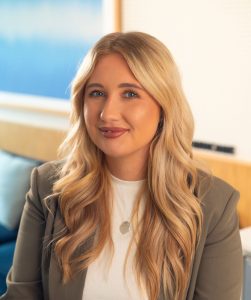The Teams call connected, and there was Linda — someone I have always enjoyed speaking to due to her bright and optimistic nature. We started off with a lighthearted exchange about the rare sunshine gracing London and our hectic schedules, noting how we had to reschedule this call three times. It was great to finally catch up with her again.
We talked through her varied career, reminiscing about her early days in family and local council work before she stumbled into the Health Informatics Service (HIS) for 18 months. Her first major challenge was taking paper out of GP practices and replacing it with SystmOne. Initially, the GP practice admin staff and nurses, who were heavily reliant on paper, were understandably resistant to change. However, three months later, they were asked if they wanted to revert to the old system but they loved the new digital system and the change it brought. Linda recalled that it was such an amazing transformation.
She then moved to Bradford to join the NPFIT programme. “I’m showing my age now, as you were probably in nursery!” she joked. The programme aimed to standardise work processes and ensure that the systems used were in the same language. It was at this point that NHS England realised that all systems should use HL7 . The programme team at Bradford worked with the national digital team to digitise end-to-end patient pathways. She believed this was the beginning of the NHS’s digital transformation journey.
Her career was filled with opportunities to meet wonderful people and take on failing or delayed projects across various organisations including Leicester Child Health Services, Luton and Dunstable NHS Foundation Trust, and Doncaster and Bassetlaw NHS Foundation Trust. She began to see the patterns of the gaps and challenges within all these systems and worked her hardest to deliver these successful projects.
Eventually, she saw a job opening at Imperial College Healthcare NHS Trust, interviewed with the CIO for the Health Records Manager role where the task was to digitise health records – and got the job. Expecting a bustling environment, she was surprised to find the team relatively quiet with not much to do. Linda wrote a business case and went out to tender for an EDM system, cutting paper records on-site, and saving the Trust £9 million. Her dedication and success on numerous projects saw her rise up the ladder to the position of Associate Director of Digital Transformation. “I think it’s really important to try and make a difference,” she said.
When asked about professional or personal setbacks, Linda acknowledged the challenges of working in a male-dominated industry. Handling her emotions was one of the hardest aspects. “I get quite animated, especially if it’s something I really believe in, and the emotion can really come through,” she explained. This sometimes meant that while she said the right words, they didn’t always hit the right points. She admits that it did take her a while to learn the intricacies of the NHS.
Reflecting on her time at the HIS, she noted that they were very monetarily driven, which she enjoyed – “my drive is to save lots of money,” she mentioned, joking that it’s something easier to do at work than in personal life.
However, focusing on monetary aspects can be difficult when patient care is interconnected. Talking about replacing systems or products is challenging because it affects everyone — clinicians and patients alike, especially if the change is perceived as being driven solely by financial considerations.
“You need to work around different stakeholders and adjust your language to who you’re speaking to. Make them understand that you are here for them to make their life easier and better for clinicians and patients.” Linda emphasised. Focusing on all the benefits, which in turn saves money, is crucial.
Language can be one of the hardest parts of working in the NHS, according to Linda. Each Trust has different ways of working, and she often has to satisfy the language across four very different trusts with different cultures and focusses as her role supports programmes running across the North West London Acute Provider Collaborative. “It’s all about how you portray your message,” she concluded. Navigating through who’s who and understanding how to work effectively is also challenging.
Linda mentioned the difficulty of being in a room full of men and trying to get them engaged and listening to her. “Are you seen as a professional or a mother?” she pondered. She notes that there are times where men will only listen to other men, but Linda believes this will change over time. “I don’t think they realise it, but maybe it’s a comfort thing!” she added.
She doesn’t necessarily see this as purely a gender issue, but more about who you know and respect. “The more you can call out things you aren’t comfortable with in a respectful yet serious way, the more inclined they are to change their behaviours and notice,” she advised.
However, Linda acknowledged that strong women can sometimes be seen as a threat, with their emotions or assertiveness dismissed as hormonal. Women face a delicate balance of upholding high standards while keeping certain egos in check. What’s crucial, Linda said, is to focus on the main driver and remember that everyone is there to deliver the best patient care, and supporting each other is key.
We agreed that it’s important to articulate your thoughts clearly while maintaining respect. “You need strong women who support other women rather than blame them to get into the circle with the men,” Linda said. “Don’t just feed the male beast; find ways to collaborate with a various number of people on different projects.”
When asked about her hopes for the next generation of leaders in digital health, Linda expressed her desire to see more women stepping into these roles and encouraging young women to seize opportunities. She ensures her team has access to development opportunities, regardless of gender, and advocates for collaborative and positive growth.
Linda has reached a position she never imagined possible and feels a responsibility to pave the way for the next generation. She hosts open-door sessions where team members can discuss anything—home, work, ideas—and she actively brings people from other teams into digital roles if they show interest, allowing them to grow and advance their careers.
Linda shared stories of team members who, with her encouragement, have climbed the ranks to managerial positions. “They are like flowers; you just have to make sure they’re in the right soil, to see them flourish” she said with a smile. It’s particularly special, she noted, when you see this with women working together. We discussed the societal misconception that women are always in competition with each other. In reality, proving that you can do the work is challenging enough—why compete when you can support one another? “We are all in this together,” she said.
I complimented Linda on her beautifully articulated thoughts. Her final advice: “Don’t give up, and don’t take things personally, even if it feels personal at times. Just keep focusing on yourself and your growth.”




